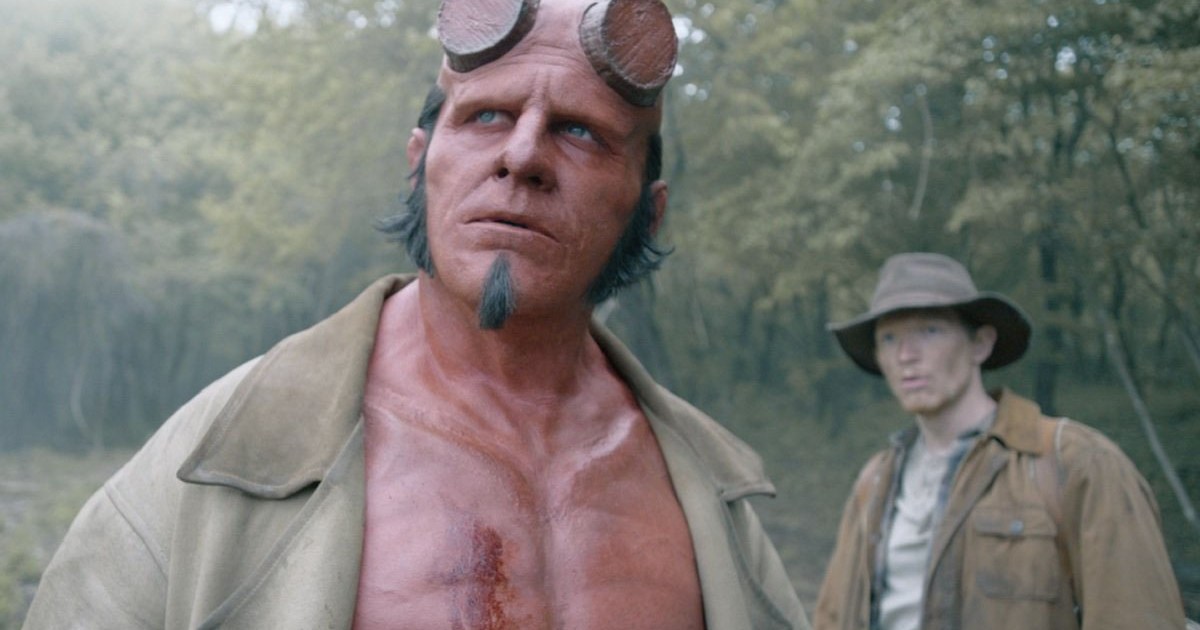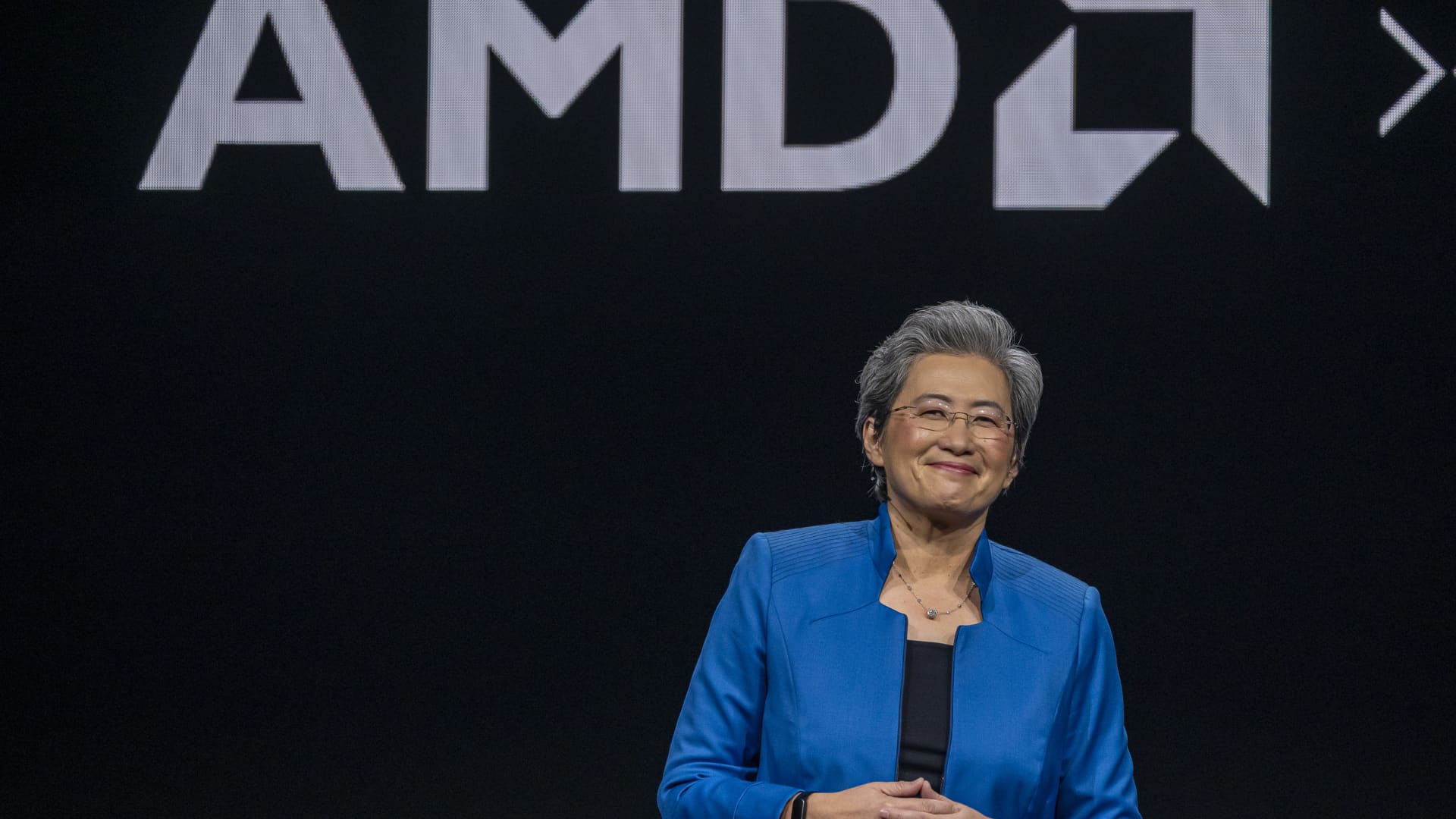Technology
I watched Hellboy: The Crooked Man so you didn’t have to. Is it the worst comic book movie ever?

Just over two decades ago, the first Hellboy movie hit theaters from director Guillermo del Toro, and it was clearly a passion project for him. Hellboy looks just as good in 2024 as it did in 2004, despite its relatively modest $60 million budget. But that film, its 2008 sequel, Hellboy II: The Golden Army, and the 2019 Hellboy reboot all look like masterpieces compared to the recently released Hellboy: The Crooked Man.
Before we get into why the new movie is so awful, I want to say that I’m a big fan of the Hellboy character. I’ve been reading Mike Mignola’s Hellboy comics since their debut in 1994, and I’ve seen every movie, including the Hellboy animated films that were direct-to-video. And I can say without reservation that Hellboy: The Crooked Man fails on every level to capture the appeal of the title character. If you ever see this movie, it won’t be a mystery as to why it skipped theaters. A wide release would have only magnified its failures.
But in the event that this Video on Demand release does go to a streaming service in the future, I feel like it’s my duty to warn other Hellboy fans away from it. I watched Hellboy: The Crooked Man so you didn’t have to… and that’s 99 minutes of my life that I’ll never get back. But everyone who has ever loved a Hellboy story should know why this adaptation deserves to be buried indefinitely.
It looks worse than YouTube fan films

How much does $20 million buy in 2024? Because the first thing you’ll notice about The Crooked Man is how cheap it looks. It’s one thing to make a movie with one-third the budget of the original Hellboy, but there have been TV pilot episodes that had lower budgets than this film and still had higher production values and more cinematic flare. Where did all of the money in this movie go? Because it certainly wasn’t the unconvincing makeup for Jack Kesy’s Hellboy, the boring Belgium countryside that stands in for the Appalachian mountains, or some truly amateurish CGI and special effects.
Director Brian Taylor has worked on some terrible comic book adaptations before, including Jonah Hex as a writer and as the co-director of Ghost Rider: Spirit of Vengeance. Both of those films were better than this one, which features shockingly bad editing, mundane camera shots, and a musical score that only calls attention to itself when it keeps repeating the same flat notes over and over again. I’ve seen YouTube fan films that have looked better than this movie that were made for a fraction of the cost.
The story fails to entertain

Typically, a bad comic book movie can’t be blamed on the men and women who created the character. But in this case, Hellboy creator Mike Mignola co-wrote the script with his frequent collaborator, Christopher Golden, as well as director Brian Taylor. That’s why it’s so surprising that this film is seemingly incapable of even capturing Hellboy’s personality.
The Crooked Man is based on one of Mignola’s stories from the Hellboy comics, but its pacing is an absolute slog to get through. Shortcuts to get the story moving in the comics are far less convincing in live-action, especially since Hellboy and Bobbie Jo Song are essentially along for the ride after getting thrown from a train without any serious injuries. The script also does a poor job of setting up the stakes for the main characters, even though one of the core trio has his soul on the line.
Ron Perlman is missed

Good casting can elevate almost any film. Unfortunately, you won’t find any good casting in this movie. Almost anyone would have had a hard time following Ron Perlman’s Hellboy from the first two movies and the animated features. He just embodies the character in a way that hasn’t been matched since. David Harbour (Stranger Things season 5) looked the part in 2019’s Hellboy reboot, but he had more of a whiny take on the main character that didn’t resonate as well.
Jack Kesy has no memorable qualities whatsoever as Hellboy. It doesn’t help that the makeup used on Kesy is far less impressive than his two predecessors. Yet he’s meant to carry this film, and Kesy simply can’t do it. His take on Hellboy is dull and doesn’t capture his working-class-hero vibe or the otherworldly aspects of the character.
The cast comes up well short of the mark

The kindest thing that can be said about Kesy is that at least his Hellboy is not as badly miscast as the film’s secondary lead, Tom Ferrell. As played by Jefferson White, Tom is supposed to be a former resident of the Appalachian mountains who is haunted by a near deal with this film’s devil, the Crooked Man (Martin Bassindal). However, White never seems to be able to capture the right emotional tone for his character, and he seems largely disinterested during his initial scenes in the movie.
Adeline Rudolph’s Bobbie Jo Song is a character who was created for this film as Hellboy’s partner in the B.P.R.D. (Bureau for Paranormal Research and Defense), but her inclusion is baffling for a few reasons. First, it was extremely difficult to buy that this Japanese-American woman was in that position barely 15 years after World War II. The film only lightly touches on racism when Bobbie Jo meets a local family in the hills, and then it never comes up again.
But the most egregious aspect of Bobbie Joe’s character is the implication that Hellboy is secretly in love with her. There’s absolutely no chemistry between Kesy and Rudolph to support that turn. And while Rudolph’s performance isn’t as lifeless as her two male co-stars, she’s not great in the movie either.
Even the film’s unintentional comedy isn’t that funny

A bad movie can still be fun to watch, especially if you’re mocking it with friends. Unfortunately, Hellboy: The Crooked Man is one of those bad movies that’s going to be hard to draw much humor from. There’s a lot of shoddy special effects and inexplicably blurry shots that might inspire some jokes. Tom Ferrell’s frequent use of his magic bone may also inspire some laughter.
Yet for the most part, this film’s joyless tone kills any sense of humor or fun that it might have had. It’s such a chore to watch that even the Mystery Science Theater 3000 or RiffTrax writing teams would be hard-pressed to make it entertaining.
If Hellboy: The Crooked Man is the best Hellboy movie that can be made in 2024, then this franchise needs a long rest. That’s a better idea than running a great concept and a fantastic main character into the ground with substandard execution.
Hellboy: The Crooked Man is now available on VOD via Amazon Prime Video and other digital outlets. But there are much better things that you can spend your money on.
Technology
I watched an AI collar make a dog talk, and it was unreal

All of us talk to our pets, but what if our pets could talk back? That’s the premise of Personifi AI’s Shazam Band, a wearable that puts your pet’s mood, movements, and emotions into words. By using AI, it actually makes a two-sided conversation possible.
If all this sounds crazy, it’s only the beginning of what makes the Shazam Band one of the maddest pieces of tech we’ve seen in a while. And if I hadn’t actually seen it working, I doubt I’d believe it was real.
This is Shazam, an AI pet collar

Shazam (no, not that one) comes in two sizes, one for a dog and one suitable for cats, and is worn like a collar. It contains various sensors, including a 6-axis gyroscope, GPS, temperature sensor, speaker, and microphone. There’s a battery inside that lasts for several weeks on a charge and another battery in the box, so you can always have one charged up and ready to go. It uses AI to interpret your pet’s movements and actions and the tone you use when speaking to it to create verbal responses that reflect your pet’s intentions, thoughts, and personality.
I know. It sounds either staggeringly stupid or like the best thing ever, depending on your level of pet obsession. But stay with me, as it’s way better thought out than you may expect.
Wondering how Shazam interprets what your pet is thinking accurately enough to put it all into words that match your pet’s personality? The company has teamed up with Matt Beisner, a dog trainer best known for the Dog: Impossible show on Disney+, to train the AI, along with social media voice-over sensation Bobby Johnson, also known as “The RxckStxr,” and voice actor Jorjeana Marie.
Another key member of the team is Roscoe, Personifi AI’s founder and CEO John McHale’s dog. Roscoe is one of several hundred animals that have already been training the AI. Over a short Zoom video call ahead of the announcement, I saw Roscoe interact with McHale and other members of the team through Shazam. Not just tail-wagging, bouncing-up-and-down interaction, but verbal interaction. No, I haven’t gone crazy; it’s as barking mad as it sounds.
One of the strangest tech demos I’ve seen

When I spoke to McHale, it was early morning at their offices, and Roscoe had not been fed or walked and was apparently a little grumpy at being woken up. We laughed at the prospect of running a tech demo using an animal, a wearable, and an AI system interpreting its actions and operating in real time and how it was a recipe for things to go wrong. In reality, the next few moments were an eye-opening glimpse of a Dr. Doolittle-style future.
Roscoe was asked if he wanted to go for a walk and chase squirrels, as well as if he had been fed yet, all spoken in that usual rhetorical way we speak to pets. Except through Shazam, Roscoe replied. Not in that if-you-listen-hard-I-think-he-said-sausages way, but actually talked.
Well, Roscoe didn’t talk, but the words came from the speaker on the Shazam wearable and in a voice that brought out Roscoe’s lackadaisical personality. Yes, he was hungry, the squirrels were likely to get chased, and he was frustrated that none of these things had happened. The voice and style will be familiar to anyone who watches Bobby Johnson’s voice-over comedy skits.
No, I haven’t gone crazy; it’s as barking mad as it sounds.
It was one of the most bizarre tech demos I’ve seen, and I smiled and laughed throughout, my mind flip-flopping between childish joy and complete bewilderment. You won’t be discussing Tolstoy with your Shazam-wearing pet, but you will see a new side to its personality.
However, there’s the potential for a more serious use case too. McHale explained that he got the idea after Roscoe had been bitten by a snake and managed to hide the problem, but was clearly not himself. Roscoe eventually underwent several serious surgeries and survived, but if he had been able to say he’d been bitten by a snake, then things could have been taken care of far sooner.
Does it turn your pet into an AI chatbot?

Even with Shazam, Roscoe is unlikely to have been able to articulate he’d been bitten by a snake, but he may have been able to vocalize that he wasn’t well in a way we could quickly understand and act upon. Any resulting vet visit would have been memorable, too, that’s for sure.
Shazam may also be able to help your pet vocalize concern for you, bringing further emotional support to the moment when they come over and check in, as they seemingly understand that you’re sad, unwell, or in need of a furry hug.
Because Shazam is AI-driven and always learning, it’s not like getting a series of canned responses that approximate emotion. It’s more like an AI chatbot, but rather than being a voice from an empty vessel, Shazam takes real emotions and your pet’s personality, or the personality you give it, and blends them into a voice, so it shouldn’t come across as something it’s not or a completely artificial fabrication. Shazam has a choice of 27 characters, each with its distinct persona and tone ranging from a witty Southern belle to a fast-talking mafia boss, plus the ability to further craft individual personality traits through the app. Several voices are available in both Spanish and Mandarin Chinese as well.
The app also shows activity tracking data from the Shazam collar, and the built-in GPS keeps track of your pet, plus it has a geofencing feature to encourage it to stay within certain set boundaries. It does so by verbally telling the pet through the speaker that it’s going where it shouldn’t, as if it were its own subconscious, which should confuse the neighbors. You set a single voice as the primary caregiver and can program other secondary voices as well, to both add safety and keep things simple for the pet.
Giving your pet a voice isn’t cheap
Putting words in your pet’s mouth is not going to be cheap. The Shazam wearable is $495 for the small version and $595 for the large version, and this includes one voice option and access to the app for a year. If you want to change voices, it’s $99 each time, and there’s a $295 subscription for every year after the first. Preorders begin on October 25, and orders will ship in February 2025.
Only you know if it’s worth it

We already recognize and try to understand our pet’s personalities and emotions. Shazam takes it to the next level by vocalizing those emotions in a language we understand. When you see it in action for the first time, it may look and sound a bit silly, but after a few moments, you will understand how much fun could be had with it and even how it could help keep your pet safe and healthy, too. How long that fun will last after the novelty has worn off is the big question. There’s also the considerable expense to find out.
Shazam is such a crazy product that you’re either going to walk away after seeing it, desperate to put in your order, or think it’s one of the most ridiculous things ever made. The voices and characters created by Personifi AI won’t be for everyone either, and the ones I heard went hard on their chosen hook — the superhero character was like an even more hyped-up Buzz Lightyear, for example. I imagine they could get quite grating. Though, if you don’t want Shazam/your pet to interrupt you, it’s as simple as saying “quiet,” just as you would normally do.
Every owner has wondered what their pet would say if it could talk, and Shazam does make it possible to somewhat answer that question. As to whether it works in the real world and outside the confines of a very short demo remains to be seen, but I came away from seeing Shazam in action thinking that there are going to be a lot of crazy cat and dog people out there who will lap this insane piece of tech up, no matter the cost.
Science & Environment
Don’t own the AI chip leaders? Jim Cramer says this might be your chance to act
Technology
Android 15 makes it harder for thieves to resell stolen phones

Android’s Theft Detection Lock started rolling out in June with a wider rollout earlier this month, but today Google is making it even better with additional features in Android 15. If you were unaware that Theft Detection Lock even existed, that’s not surprising. It’s not exactly one of the more exciting features of Android and it’s not something that’s immediately user-facing like new homescreen features tend to be.
That being said, it’s a feature that most users should become familiar with. It’ll help you become better prepared for what to do if your phone is ever stolen. For instance, if your phone gets snatched, Theft Detection Lock uses AI to sense motion commonly associated with theft and locks the screen. This way thieves don’t have immediate access to your data. The device can also be automatically locked if excessive failed attempts are made to authenticate.
With Android 15, Google is expanding the helpfulness of Theft Detection Lock with the addition of authentication requirements for settings that thieves tend to go after.
Theft Detection Lock in Android 15 now requires authentication to turn off Find My Device
Find My Device and the Find My Device Network are great tools for any user to help locate a device that’s been misplaced. Unfortunately, thieves know how useful this is and tend to target it by disabling the feature. Making it harder for you to locate the phone and easier for them to resell it. Starting with Android 15, a new authentication requirement will be in place to prevent turning this off. So if your device gets stolen, thieves will still need to authenticate if they want to turn the feature off.
Google says that accessing this setting to turn it off will now require either a biometric authentication or the entry of a PIN or password. While not impossible to bypass, it’ll be a lot harder for the average thief to get around these protections. Another new authentication requirement being added is for removing your SIM.
Device resets become harder, ‘Identity Check’ coming later this year
When a thief steals your phone, the intention is to probably sell that device to make some quick cash. However, that’s a lot harder to do without being able to factory reset the device. With the new Theft Detection Lock improvements it will now be harder to perform a device reset without the device’s Google account credentials. This and the other features are most certainly useful, but of course, not foolproof. That being said, these are also meant, at least in part, to be deterrents for thieves as devices won’t be as easy to crack and resell.
Google mentions another feature coming later this year that should help add to these deterrents called Identity Check. This feature will be opt-in so it won’t be on by default. If enabled, however, biometric authentication will be needed to access a variety of Google account and device settings. This includes things like disabling the theft protection or changing the PIN. This authentication requirement also kicks in if someone is trying to access your passkey from a location that isn’t trusted.
Technology
You’ll soon be able to safely and easily move your passkeys between password managers

By now, most people know passkeys offer a better way to protect their online credentials than passwords. Nearly every tech company of note, including Apple, Google and Microsoft, supports the protocol. Moreover, despite a slow start, adoption has dramatically increased in the last year, with, for instance, password manager Dashlane recently noting a 400% increase in use since the beginning of 2024. Still, not everyone knows they don’t need to rely on passwords to protect their online identity, and transferring your passkeys between platforms isn’t as easy as it should be.
That’s why the FIDO Alliance, the coalition of organizations behind the technology, is working to make it easier to do just that. On Tuesday, the group published draft specifications for the Credential Exchange Protocol (CXP) and Credential Exchange Format (CXF), two standards that, once adopted by the industry, will allow you to safely and seamlessly move all your passkeys and passwords between different apps and platforms.
With some of the biggest names in the industry collaborating on the effort (including Apple, Google, 1Password, Bitwarden, and Dashlane, to name a few), there’s a very good chance we’re looking at a future where your current password manager — particularly if you use one of the first-party ones offered by Apple or Google — won’t be the reason you can’t switch platforms. And that’s a very good thing.
“It is critical that users can choose the credential management platform they prefer, and switch credential providers securely and without burden,” the FIDO Alliance said. “Until now, there has been no standard for the secure movement of credentials, and often the movement of passwords or other credentials has been done in the clear.”
The CXP and CXF standards aren’t ready for prime time just yet. The FIDO Alliance plans to collect feedback before it publishes the final set of specifications and gives its members the go-ahead to implement the technology.
If you buy something through a link in this article, we may earn commission.
Technology
Arm touts growing ecosystem of sustainable AI datacenter silicon


Arm said that a year from its introduction, the Arm Total Design ecosystem has doubled in size, drivingglobal silicon innovation for sustinability. Datacenters are constantly challenged to balance power demands with the growth of AI workloads, the increasing cost and complexity of developing chips, and the need for sustainability, Arm said. Eddie R…Read More
Technology
Career Karma founders launch OutRival to help companies build AI agents

Ruben Harris and Timur Meyster, the founders of the upskilling platform Career Karma, announced today the launch of the company OutRival, which offers a service that hosts and lets businesses build their own customer service agents to take on customer interactions.
AI agent companies are hot right now, and AI is one of the only sectors in venture capital seeing a flood of money rush toward it. As of September, the VC industry poured at least $64.1 billion into the AI sector and a third of all VC dollars this year went to AI startups, according to PitchBook data reported by the Wall Street Journal.
Startups building AI agents have alone raised more than $8 billion this year, according to PitchBook data reported by the Verge.
Although OutRival is entering a crowded field, Harris feels now is the perfect time to take aim at the industry. Harris said he and Meyster saw firsthand how important personalized interactions are, as well as the limitations of existing systems like automated phone calls.
“Today with AI, not only are companies in every industry making technology a part of their core operations but AI is fundamentally changing how they do business and how people work,” Harris told TechCrunch. “We knew there had to be a way to scale personalized experiences using AI while making the technology accessible to people closest to the customer journey.”
His company aims to differentiate itself from its competitors by helping — rather than replacing — existing consumer teams, encouraging them to easily build AI agents that can work with existing tools and systems to help converse with customers. The company has operated in beta mode for the past two years and says it’s already working with admissions teams at colleges to help ease workflow. It plans to expand to other industries.
Harris says Career Karma will continue as a separate company, just now owned by OutRival. (It’s even releasing a Netflix documentary on October 16 in partnership with Workday and LeBron James’ SpringHill Company about hiring overlooked talent). Harris told TechCrunch that they took everything they’ve learned from building Career Karma and applied it to the launch of OutRival.
“Career Karma taught us the power of personalized, human-centric interactions and how important it is to scale those experiences without losing the human touch,” he said. “OutRival takes what we’ve built for Career Karma and scales it, making it accessible for enterprises across industries.”
Harris says that Career Karma will now use OutRival’s technology to enhance its own operations, creating AI-driven support to help with its job training platform.
Investors are clearly down for the ride. OutRival is leveraging leftover capital from the $40 million Series B round Career Karma raised in 2022 and says his investors, which include Jack Altman and Initialized Capital, are excited to see what he and Meyster do next.
“We’re excited to partner with more companies and show how OutRival can be a game-changer in delivering exceptional customer experiences,” Harris said.
TechCrunch has an AI-focused newsletter! Sign up here to get it in your inbox every Wednesday.
-

 Science & Environment4 weeks ago
Science & Environment4 weeks agoHyperelastic gel is one of the stretchiest materials known to science
-

 Technology4 weeks ago
Technology4 weeks agoWould-be reality TV contestants ‘not looking real’
-

 Science & Environment4 weeks ago
Science & Environment4 weeks agoHow to unsnarl a tangle of threads, according to physics
-

 Science & Environment4 weeks ago
Science & Environment4 weeks ago‘Running of the bulls’ festival crowds move like charged particles
-

 Science & Environment4 weeks ago
Science & Environment4 weeks agoMaxwell’s demon charges quantum batteries inside of a quantum computer
-

 Science & Environment4 weeks ago
Science & Environment4 weeks agoLiquid crystals could improve quantum communication devices
-

 Technology3 weeks ago
Technology3 weeks agoIs sharing your smartphone PIN part of a healthy relationship?
-

 Womens Workouts3 weeks ago
Womens Workouts3 weeks ago3 Day Full Body Women’s Dumbbell Only Workout
-

 Science & Environment4 weeks ago
Science & Environment4 weeks agoQuantum ‘supersolid’ matter stirred using magnets
-

 Science & Environment3 weeks ago
Science & Environment3 weeks agoX-rays reveal half-billion-year-old insect ancestor
-

 Science & Environment4 weeks ago
Science & Environment4 weeks agoWhy this is a golden age for life to thrive across the universe
-

 Science & Environment4 weeks ago
Science & Environment4 weeks agoSunlight-trapping device can generate temperatures over 1000°C
-

 Science & Environment4 weeks ago
Science & Environment4 weeks agoNerve fibres in the brain could generate quantum entanglement
-

 Science & Environment4 weeks ago
Science & Environment4 weeks agoQuantum forces used to automatically assemble tiny device
-

 Science & Environment4 weeks ago
Science & Environment4 weeks agoITER: Is the world’s biggest fusion experiment dead after new delay to 2035?
-

 Science & Environment4 weeks ago
Science & Environment4 weeks agoHow to wrap your mind around the real multiverse
-

 Science & Environment4 weeks ago
Science & Environment4 weeks agoA slight curve helps rocks make the biggest splash
-
News4 weeks ago
the pick of new debut fiction
-

 News3 weeks ago
News3 weeks agoOur millionaire neighbour blocks us from using public footpath & screams at us in street.. it’s like living in a WARZONE – WordupNews
-

 Science & Environment4 weeks ago
Science & Environment4 weeks agoLaser helps turn an electron into a coil of mass and charge
-

 Science & Environment4 weeks ago
Science & Environment4 weeks agoTime travel sci-fi novel is a rip-roaringly good thought experiment
-

 Science & Environment4 weeks ago
Science & Environment4 weeks agoPhysicists are grappling with their own reproducibility crisis
-

 Science & Environment4 weeks ago
Science & Environment4 weeks agoNuclear fusion experiment overcomes two key operating hurdles
-

 News4 weeks ago
News4 weeks ago▶️ Hamas in the West Bank: Rising Support and Deadly Attacks You Might Not Know About
-

 News4 weeks ago
News4 weeks agoYou’re a Hypocrite, And So Am I
-
Business2 weeks ago
Eurosceptic Andrej Babiš eyes return to power in Czech Republic
-

 Sport4 weeks ago
Sport4 weeks agoJoshua vs Dubois: Chris Eubank Jr says ‘AJ’ could beat Tyson Fury and any other heavyweight in the world
-

 Science & Environment4 weeks ago
Science & Environment4 weeks agoA new kind of experiment at the Large Hadron Collider could unravel quantum reality
-

 News4 weeks ago
News4 weeks ago▶️ Media Bias: How They Spin Attack on Hezbollah and Ignore the Reality
-

 Science & Environment4 weeks ago
Science & Environment4 weeks agoCaroline Ellison aims to duck prison sentence for role in FTX collapse
-

 Science & Environment4 weeks ago
Science & Environment4 weeks agoRethinking space and time could let us do away with dark matter
-

 News4 weeks ago
News4 weeks agoNew investigation ordered into ‘doorstep murder’ of Alistair Wilson
-

 Technology3 weeks ago
Technology3 weeks agoWhy Machines Learn: A clever primer makes sense of what makes AI possible
-

 Technology2 weeks ago
Technology2 weeks agoQuantum computers may work better when they ignore causality
-
Business2 weeks ago
Should London’s tax exiles head for Spain, Italy . . . or Wales?
-

 Football2 weeks ago
Football2 weeks agoFootball Focus: Martin Keown on Liverpool’s Alisson Becker
-

 Sport2 weeks ago
Sport2 weeks agoWatch UFC star deliver ‘one of the most brutal knockouts ever’ that left opponent laid spark out on the canvas
-

 Science & Environment4 weeks ago
Science & Environment4 weeks agoA tale of two mysteries: ghostly neutrinos and the proton decay puzzle
-
News4 weeks ago
The Project Censored Newsletter – May 2024
-

 Technology2 weeks ago
Technology2 weeks ago‘From a toaster to a server’: UK startup promises 5x ‘speed up without changing a line of code’ as it plans to take on Nvidia, AMD in the generative AI battlefield
-

 MMA2 weeks ago
MMA2 weeks agoConor McGregor challenges ‘woeful’ Belal Muhammad, tells Ilia Topuria it’s ‘on sight’
-

 Technology2 weeks ago
Technology2 weeks agoMicrophone made of atom-thick graphene could be used in smartphones
-

 News4 weeks ago
News4 weeks agoIsrael strikes Lebanese targets as Hizbollah chief warns of ‘red lines’ crossed
-

 Health & fitness4 weeks ago
Health & fitness4 weeks agoThe secret to a six pack – and how to keep your washboard abs in 2022
-

 Science & Environment4 weeks ago
Science & Environment4 weeks agoFuture of fusion: How the UK’s JET reactor paved the way for ITER
-

 Science & Environment4 weeks ago
Science & Environment4 weeks agoPhysicists have worked out how to melt any material
-

 Technology4 weeks ago
Technology4 weeks agoThe ‘superfood’ taking over fields in northern India
-

 Science & Environment4 weeks ago
Science & Environment4 weeks agoUK spurns European invitation to join ITER nuclear fusion project
-

 CryptoCurrency4 weeks ago
CryptoCurrency4 weeks agoCardano founder to meet Argentina president Javier Milei
-

 TV3 weeks ago
TV3 weeks agoCNN TÜRK – 🔴 Canlı Yayın ᴴᴰ – Canlı TV izle
-

 News3 weeks ago
News3 weeks agoWhy Is Everyone Excited About These Smart Insoles?
-

 Technology3 weeks ago
Technology3 weeks agoRobo-tuna reveals how foldable fins help the speedy fish manoeuvre
-

 Technology3 weeks ago
Technology3 weeks agoGet ready for Meta Connect
-

 Technology2 weeks ago
Technology2 weeks agoUniversity examiners fail to spot ChatGPT answers in real-world test
-
Business2 weeks ago
Ukraine faces its darkest hour
-
Politics3 weeks ago
Robert Jenrick vows to cut aid to countries that do not take back refused asylum seekers | Robert Jenrick
-

 Sport4 weeks ago
Sport4 weeks agoUFC Edmonton fight card revealed, including Brandon Moreno vs. Amir Albazi headliner
-

 Science & Environment4 weeks ago
Science & Environment4 weeks agoWhy we need to invoke philosophy to judge bizarre concepts in science
-
Politics4 weeks ago
UK consumer confidence falls sharply amid fears of ‘painful’ budget | Economics
-

 Science & Environment3 weeks ago
Science & Environment3 weeks agoMeet the world's first female male model | 7.30
-

 Womens Workouts3 weeks ago
Womens Workouts3 weeks ago3 Day Full Body Toning Workout for Women
-

 Health & fitness2 weeks ago
Health & fitness2 weeks agoThe 7 lifestyle habits you can stop now for a slimmer face by next week
-

 Politics4 weeks ago
Politics4 weeks agoTrump says he will meet with Indian Prime Minister Narendra Modi next week
-

 CryptoCurrency4 weeks ago
CryptoCurrency4 weeks agoEthereum is a 'contrarian bet' into 2025, says Bitwise exec
-

 Science & Environment4 weeks ago
Science & Environment4 weeks agoBeing in two places at once could make a quantum battery charge faster
-

 News4 weeks ago
News4 weeks agoHow FedEx CEO Raj Subramaniam Is Adapting to a Post-Pandemic Economy
-

 CryptoCurrency4 weeks ago
CryptoCurrency4 weeks agoDecentraland X account hacked, phishing scam targets MANA airdrop
-

 CryptoCurrency4 weeks ago
CryptoCurrency4 weeks agoBitcoin miners steamrolled after electricity thefts, exchange ‘closure’ scam: Asia Express
-

 CryptoCurrency4 weeks ago
CryptoCurrency4 weeks agoDZ Bank partners with Boerse Stuttgart for crypto trading
-

 CryptoCurrency4 weeks ago
CryptoCurrency4 weeks agoLow users, sex predators kill Korean metaverses, 3AC sues Terra: Asia Express
-

 CryptoCurrency4 weeks ago
CryptoCurrency4 weeks agoBlockdaemon mulls 2026 IPO: Report
-
Business4 weeks ago
Thames Water seeks extension on debt terms to avoid renationalisation
-
Politics4 weeks ago
‘Appalling’ rows over Sue Gray must stop, senior ministers say | Sue Gray
-

 MMA3 weeks ago
MMA3 weeks agoRankings Show: Is Umar Nurmagomedov a lock to become UFC champion?
-

 Womens Workouts3 weeks ago
Womens Workouts3 weeks agoBest Exercises if You Want to Build a Great Physique
-

 Womens Workouts3 weeks ago
Womens Workouts3 weeks agoEverything a Beginner Needs to Know About Squatting
-

 News3 weeks ago
News3 weeks agoFour dead & 18 injured in horror mass shooting with victims ‘caught in crossfire’ as cops hunt multiple gunmen
-

 Servers computers3 weeks ago
Servers computers3 weeks agoWhat are the benefits of Blade servers compared to rack servers?
-

 Business2 weeks ago
Business2 weeks agoWhen to tip and when not to tip
-

 Entertainment1 week ago
Entertainment1 week agoChristopher Ciccone, artist and Madonna’s younger brother, dies at 63
-

 News4 weeks ago
News4 weeks agoChurch same-sex split affecting bishop appointments
-

 News4 weeks ago
News4 weeks agoBrian Tyree Henry on voicing young Megatron, his love for villain roles
-

 Health & fitness4 weeks ago
Health & fitness4 weeks agoThe maps that could hold the secret to curing cancer
-

 Science & Environment4 weeks ago
Science & Environment4 weeks agoTiny magnet could help measure gravity on the quantum scale
-

 CryptoCurrency4 weeks ago
CryptoCurrency4 weeks agoDorsey’s ‘marketplace of algorithms’ could fix social media… so why hasn’t it?
-

 CryptoCurrency4 weeks ago
CryptoCurrency4 weeks agoBitcoin bulls target $64K BTC price hurdle as US stocks eye new record
-

 News4 weeks ago
News4 weeks agoBrian Tyree Henry on voicing young Megatron, his love for villain roles
-

 CryptoCurrency4 weeks ago
CryptoCurrency4 weeks agoCoinbase’s cbBTC surges to third-largest wrapped BTC token in just one week
-

 News3 weeks ago
News3 weeks agoShocking ‘kidnap’ sees man, 87, bundled into car, blindfolded & thrown onto dark road as two arrested
-

 Travel3 weeks ago
Travel3 weeks agoDelta signs codeshare agreement with SAS
-

 Technology2 weeks ago
Technology2 weeks agoThe best robot vacuum cleaners of 2024
-

 Science & Environment4 weeks ago
Science & Environment4 weeks agoHow one theory ties together everything we know about the universe
-
Business4 weeks ago
JPMorgan in talks to take over Apple credit card from Goldman Sachs
-

 Science & Environment4 weeks ago
Science & Environment4 weeks agoQuantum time travel: The experiment to ‘send a particle into the past’
-

 CryptoCurrency4 weeks ago
CryptoCurrency4 weeks agoLouisiana takes first crypto payment over Bitcoin Lightning
-

 Science & Environment4 weeks ago
Science & Environment4 weeks agoHow do you recycle a nuclear fusion reactor? We’re about to find out
-

 CryptoCurrency4 weeks ago
CryptoCurrency4 weeks agoRedStone integrates first oracle price feeds on TON blockchain
-

 CryptoCurrency4 weeks ago
CryptoCurrency4 weeks agoSEC asks court for four months to produce documents for Coinbase
-

 CryptoCurrency4 weeks ago
CryptoCurrency4 weeks ago‘No matter how bad it gets, there’s a lot going on with NFTs’: 24 Hours of Art, NFT Creator
-
Business4 weeks ago
How Labour donor’s largesse tarnished government’s squeaky clean image


You must be logged in to post a comment Login